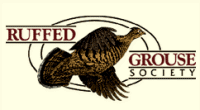
It’s not a hobby.
It’s not a part time job. It is our job!
This article by veteran Outdoor Writer, Tom Hanrahan, appeared in the March 2004 issue of the
Northwoods Sporting Journal.
Paul Laney: Champion Cat Hunter
By Tom Hanrahan
Pitchfork thin and six feet tall, Paul Laney slips through the most punishing bobcat coverts in a spectral flash of green wool and neoprene-webbed floats. He is a young man with that rarest of traditional Maine woods skills: running bobcats with hounds in Maine’s desolate winter landscape.
The hunt is on.
The 27-year-old Gardiner native and I are chasing after his two prized Plott hounds, Suzie and Lilly. The dogs are in hot pursuit of a big tomcat, possibly a trophy 40-pounder. To keep up with the 130 pound wraith a man has to be in No.1 Grade A Prime condition. Anything less and you will be watching Paul Laney and his dogs rapidly disappear into the tangled cover, never to find them again.
Through the snarled pines and knotted thickets Laney
charges with myself in ragged pursuit towards a large tomcat held at bay by the snarling, lunging, howling hounds, their teeth clattering and jaws snapping, a royal hullabaloo. It’s a crash course in hellzapoppin’, stomach-churning, adrenalin-pumping madness once tasted never forgotten.
The cat hisses and spits and scratches one dog with its knife-sharp claws, blood rosily misting through the snapping cold air. I fire once from a borrowed .22 caliber Cold Woodsman. The short report is swallowed up by the downy snow and the chase ends in an abrupt, towering silence. My heart is ready to burst from my chest in a spasm of giddy victory and the blood in my veins is gushing like a fire hose cut by an ax. I have only one question for my young guide:
“When do we do this again?” I say, gasping for air.
Laney and his dogs posted some spectacular results this year. He and his partner, Dave Tobey, a longtime and venerable Grand Lake Stream master guide, broke an unofficial state record for cats established in the late 1970s by legendary Maine cat hunters George Perry, Rollie McLaughlin, and Don Helstrom.

That talented crew of cat hunters tagged 31 coveted Lynx rufus specimens back then, using three dogs and making good use of a longer season. Laney and Tobey racked up 33 in 2003 – in little more than a month.
Most cat hunters settle for considerably less. The person considered by many to have shot the most cats
in memory, Topsfield’s Ash Peasley, told me he shot 55 in 1961-1962. Peasley, 79 and living in Florida, once shot five cats on Christmas day, another unofficial record that still stands. Another venerable cat hunter, known to almost all of today’s hunters, was V.E. Lynch.
“I started my dogs at a very early age to run game,” says Laney. “I look for brains, her actions, mannerisms, how she reacts with the litter. I watch for the one who wants to be out in front. In every litter there is an alpha female. Females are easier to train. They’re more eager to please you. It’s just my personal preference. And they are smaller, so they can get through more dense stuff and they have a tighter foot. But the dog is only as smart as the owner and I am always with them to help with any tricks a cat might pull to shake them off the track.” December has turned out to be a wash in recent times,
for lack of good snow. Laney prefers to hunt n 15 inches of soft snow, in temperatures ranging from 15 to 20 degrees.
“A big cat will start to sink in the snow when it begins to run and jump,” he explains. “The dog has to keep them jumping. If the cat walks, it can snowshoe. Its foot spreads out and covers the snow. Dogs who make losses fail to keep the cat jumping. And of course when the cat is jumping, it tires more quickly and starts to sweat up, which makes the scent trail stronger. Plus, they open their mouth when they run, just like you would if you were running flat out, and they get snow in their face. That’s what makes Suzie and Lilly such excellent dogs, the more the cat runs, the harder they run. And unlike 90 percent of the dogs out there, they don’t start tonguing until they jump the cat, so the cat doesn’t hear them coming.”
The person considered by many to have shot the most cats in memory, Topsfield’s
Ash Peasley, told me he shot 55 in 1961 – 1962. Peasley, 79 and living in Florida, once shot five cats on Christmas day, another unofficial record that still stands.
No hunt can commence until Laney and Tobey find a fresh cat track. Bobcat tracks are similar to coyote tracks and it takes a keen, practiced eye to ferret out the differences. Cats stagger step as they walk and punch a neater hole in the snow than a coyote, Tobey notes.
“Coyote tracks are more splashy,” says Tobey, who stores 30 years of detailed knowledge of the downeast countryside in his head. “And the pad on a cat is rounder. The toes are more in front, coyotes’ front two toes stick out more and you can usually spot their toenails. It takes a lot of looking over a lot of years.”
I watched as the two guides worked to isolate a cat inside a particular patch of thickets, “cutting ’em down” they call it – dense underbrush packed with evergreen, where rabbits and deer can be found in profusion. Laney asks me to note that where coyote snaring programs are in place, the bobcat and deer populations have rebounded.
“A coyote will eat as many as 100 rabbits a year and that many rabbits would probably last a family of cats the entire winter,” he says. “Coyotes kill something and then move to kill something else. Cats will cache their kill and feed off it until it is gone. Coyote snaring is critical in my mind to a successful cat population. There should be more of it all across the state.”
“A bobcat is a highly intelligent creature,” he notes. “And they don’t like human contact. A cat has tremendous eyesight and hearing, but not as keen a sense of smell at the coyote. Smart is why you don’t see them very often. Many sports hire guides who don’t even cut a track all season, not to mention seeing or killing a cat. I wouldn’t take people out if I didn’t think I could find them a cat. And if a guide doesn’t have a good dog, it’s a complete waste of time and money. There’s an awful lot of people out there who have no business taking people on cat hunts, but they do. It gives all of us a bad name.”
There are three ways a bobcat can be taken with hounds. The dogs can tree a cat. Laney recommends using a 12 gauge shotgun, modified choke – loaded with #2 lead bird shot to dispatch the animal. Famed taxidermist, Art Fayta of Pownal, cringes when he hears this because so many hunters “pepper the cats with shot and leave dozens of tiny holes in the pelt that take me all day to sew up.” But Laney argues that unless the hunter makes a vital hit with a .22 bullet the cat will run away.
“Plus,” says Laney, “there’s a greater danger of my dogs being hurt or killed by a wounded cat.” Suzie, 3 1/2 years old, has gotten 67 cats in her life. She got 33 this year: 16 treed, 11 bayed, and 6 on the ground. Lilly, a year old this January, has 28 kills.
Cats can also be taken at bay as described earlier – and while running from the hounds on the ground. Hunters must be
on the alert from the moment the dogs start to howl and can expect to see a cat leap from the brush without warning. “My dogs are so fast that most of the time they tree the cat.” says Laney. “And if you don’t catch up with them soon enough and they’ve bayed it, they’ll kill the cat themselves.”
“Paul hunts hard with his dogs and he’s there alongside them every minute which is so critical,” says the soft-spoken, easy-going Tobey. “So many things can go wrong. If you’re not in there not participating with the dog, helping the dogs to figure out the tricks the cat can pull which defeat so many dogs (dashing along a log to lose them, running figure eights to throw them off the trail) it doesn’t go as well. That’s where high success comes, when you’re with your dogs every step. And Paul is able to do that, which requires phenomenal strength and stamina.”
Tobey says he has shared his knowledge about cats, and Laney himself learned a lot of cat secrets from his father, veteran cat hunter and houndsman, Dick Laney. Another charter member of this cat cartel is inveterate cat hunter and raconteur, Roger Milliken, also of Grand Lake Stream.
“Roger is my good luck charm,” says Laney. “Every time he comes with me I have a good day. Roger came with me five days this season and I show 10 cats when he was with me. I’m thinking of tying him to the back of the truch. And he has helped me with tips like knowing to look for loose bark on the snow at the base of a tree when the dogs have treed a cat and I can’t locate it. They shed that bark clawing their way up. Saved me half a dozen cats.”
“Today we jumped cats in half the time of the old days. Back when my dad was hunting cat it would take him 5 – 6
hours to jump a cat a lot of the time because there were fewer cats. Today there are more cats, more rabbits, thicker cover, so the cats don’t have to search for food as far as they did before. So it is really a totally different hunt.”
Laney and Tobey stress that they range hundreds of miles over cat country and are careful to never deplete cats in any one area.
“Some hunters will wipe them out in a particular area if they find a group,” says Laney. “We’ll take one and then move to a different area. We respect the resource and if we see a small cat we let live to grow up and be a big cat.”
Laney would like to see the bobcat hunting season expanded. “I’d like to see a threshold hunt, that is once a certain number of cats are killed, 300 say – the hunt would come to an end. We don’t get much of a hunt in December,
but you don’t want to go too far past February, because that’s when they start to breed.” Hunters and trappers took about 200 cats in Maine last year.
If you’re interested in cat hunting, be prepared to sweat. And be prepared to hunt in challenging conditions, including dense cover and sub-zero temperatures (The week I hunted with them in January saw wind chills in excess of 50 degrees below zero).
“When I met Paul I told him why I knew he was so good,” says Tobey, one of the few guides in Maine to have supported himself and his family over the years exclusively by working outdoors year-round. I said, “You’re half crazy.”
“I had a hip replacement this year and thought my cat hunting days were over,” says a smiling Tobey, “but my doctor said I can continue if I’m careful, and now I’m thinking of getting a dog again. Paul and I have been at this for three
years. I’ve known his dad for 25 years – and it’s kind of like a miracle.”
“It’s important to continue the Maine tradition of hunting with dogs, that man and dog can still go out and hunt together,” he says. “So many young hunters started out as kids hunting rabbits with a beagle, you know, and blossomed into full-fledged sportsmen. Bear, rabbits, birds, it’s a fine tradition and I’d like to see it kept alive.”
Laney is laconic.
“I could never stand to work behind a desk,” he says. “I’d go out of my mind.”
He hops back into his Silverado after a three-hour jaunt with the dogs and grabs a sandwich. A 30 pound silver-tipped bobcat is riding in the back. Pulls on a bottle of Gatorade. The radio chatters. Laney dials up the heat. He is only two bites into the sandwich when he grabs the microphone and
hails Tobey.
“How about it, Dave?” he says. “Where we goin’ next?”
With a Gazetteer perched on his lap he throws the truck into gear. Red-faced from the cold, his jacket coated in a dusting of snow, we are only minutes down the road when he slows the big Chevy and stops.
“Got a fresh track,” he says. Moments later, snowshoes on, he releases Suzie and Lilly. Another chase has begun.
|
Tom Hanrahan is a veteran newspaperman and a Master Maine Guide |



